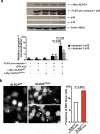Mutation of NLRC4 causes a syndrome of enterocolitis and autoinflammation
- PMID: 25217960
- PMCID: PMC4177367
- DOI: 10.1038/ng.3066
Mutation of NLRC4 causes a syndrome of enterocolitis and autoinflammation
Abstract
Upon detection of pathogen-associated molecular patterns, innate immune receptors initiate inflammatory responses. These receptors include cytoplasmic NOD-like receptors (NLRs) whose stimulation recruits and proteolytically activates caspase-1 within the inflammasome, a multiprotein complex. Caspase-1 mediates the production of interleukin-1 family cytokines (IL1FCs), leading to fever and inflammatory cell death (pyroptosis). Mutations that constitutively activate these pathways underlie several autoinflammatory diseases with diverse clinical features. We describe a family with a previously unreported syndrome featuring neonatal-onset enterocolitis, periodic fever, and fatal or near-fatal episodes of autoinflammation. We show that the disease is caused by a de novo gain-of-function mutation in NLRC4 encoding a p.Val341Ala substitution in the HD1 domain of the protein that cosegregates with disease. Mutant NLRC4 causes constitutive IL1FC production and macrophage cell death. Infected macrophages from affected individuals are polarized toward pyroptosis and exhibit abnormal staining for inflammasome components. These findings identify and describe the cause of a life-threatening but treatable autoinflammatory disease that underscores the divergent roles of the NLRC4 inflammasome.
Figures





Comment in
-
NLRC4 gets out of control.Nat Genet. 2014 Oct;46(10):1048-9. doi: 10.1038/ng.3100. Nat Genet. 2014. PMID: 25257084
-
Autoinflammation: NLRC4 mutation causes rare autoinflammatory disease.Nat Rev Rheumatol. 2014 Nov;10(11):635. doi: 10.1038/nrrheum.2014.170. Epub 2014 Sep 30. Nat Rev Rheumatol. 2014. PMID: 25266450 No abstract available.
References
-
- Mariathasan S, Monack DM. Inflammasome adaptors and sensors: intracellular regulators of infection and inflammation. Nat Rev Immunol. 2007;7:31–40. - PubMed
-
- Dinarello CA. Immunological and inflammatory functions of the interleukin-1 family. Annu Rev Immunol. 2009;27:519–50. - PubMed
-
- Ozen S, Bilginer Y. A clinical guide to autoinflammatory diseases: familial Mediterranean fever and next-of-kin. Nat Rev Rheumatol. 2014;10:135–47. - PubMed
-
- Thornberry NA, et al. A novel heterodimeric cysteine protease is required for interleukin-1 beta processing in monocytes. Nature. 1992;356:768–74. - PubMed
-
- Miao EA, et al. Cytoplasmic flagellin activates caspase-1 and secretion of interleukin 1beta via Ipaf. Nat Immunol. 2006;7:569–75. - PubMed
Publication types
MeSH terms
Substances
Grants and funding
LinkOut - more resources
Full Text Sources
Other Literature Sources
Molecular Biology Databases

